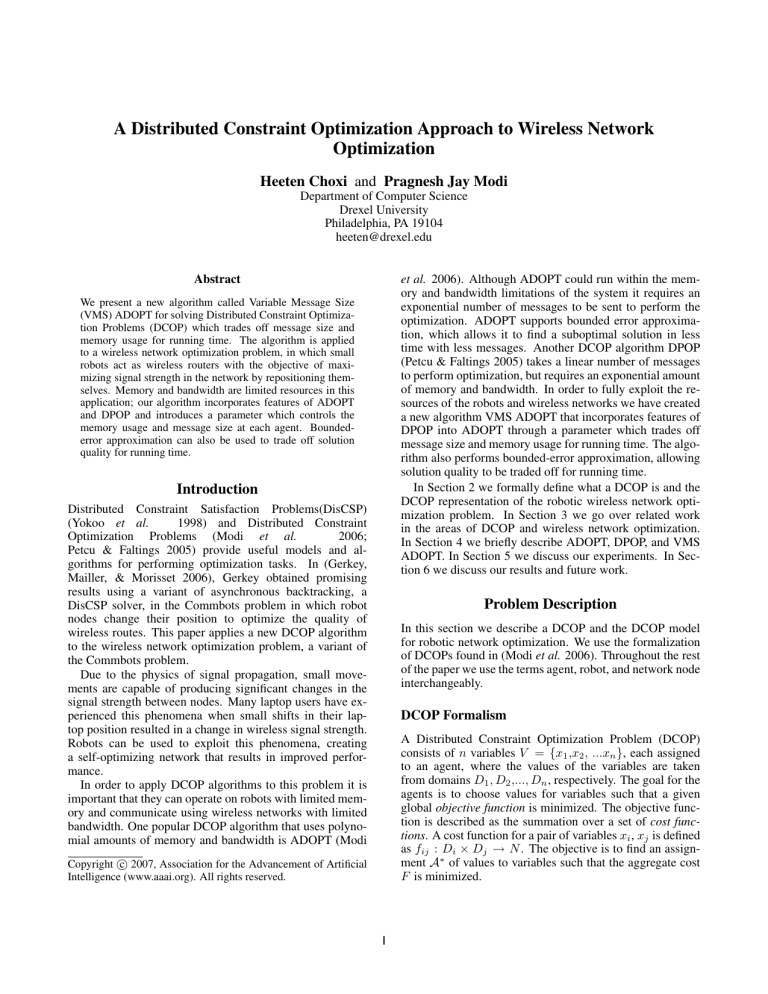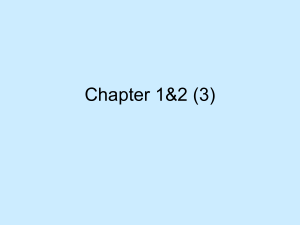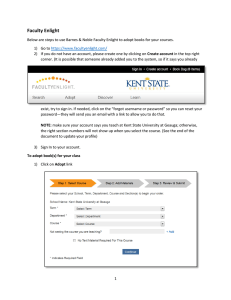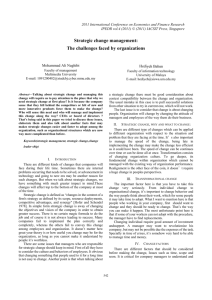
A Distributed Constraint Optimization Approach to Wireless Network
Optimization
Heeten Choxi and Pragnesh Jay Modi
Department of Computer Science
Drexel University
Philadelphia, PA 19104
heeten@drexel.edu
et al. 2006). Although ADOPT could run within the memory and bandwidth limitations of the system it requires an
exponential number of messages to be sent to perform the
optimization. ADOPT supports bounded error approximation, which allows it to find a suboptimal solution in less
time with less messages. Another DCOP algorithm DPOP
(Petcu & Faltings 2005) takes a linear number of messages
to perform optimization, but requires an exponential amount
of memory and bandwidth. In order to fully exploit the resources of the robots and wireless networks we have created
a new algorithm VMS ADOPT that incorporates features of
DPOP into ADOPT through a parameter which trades off
message size and memory usage for running time. The algorithm also performs bounded-error approximation, allowing
solution quality to be traded off for running time.
In Section 2 we formally define what a DCOP is and the
DCOP representation of the robotic wireless network optimization problem. In Section 3 we go over related work
in the areas of DCOP and wireless network optimization.
In Section 4 we briefly describe ADOPT, DPOP, and VMS
ADOPT. In Section 5 we discuss our experiments. In Section 6 we discuss our results and future work.
Abstract
We present a new algorithm called Variable Message Size
(VMS) ADOPT for solving Distributed Constraint Optimization Problems (DCOP) which trades off message size and
memory usage for running time. The algorithm is applied
to a wireless network optimization problem, in which small
robots act as wireless routers with the objective of maximizing signal strength in the network by repositioning themselves. Memory and bandwidth are limited resources in this
application; our algorithm incorporates features of ADOPT
and DPOP and introduces a parameter which controls the
memory usage and message size at each agent. Boundederror approximation can also be used to trade off solution
quality for running time.
Introduction
Distributed Constraint Satisfaction Problems(DisCSP)
(Yokoo et al.
1998) and Distributed Constraint
Optimization Problems (Modi et al.
2006;
Petcu & Faltings 2005) provide useful models and algorithms for performing optimization tasks. In (Gerkey,
Mailler, & Morisset 2006), Gerkey obtained promising
results using a variant of asynchronous backtracking, a
DisCSP solver, in the Commbots problem in which robot
nodes change their position to optimize the quality of
wireless routes. This paper applies a new DCOP algorithm
to the wireless network optimization problem, a variant of
the Commbots problem.
Due to the physics of signal propagation, small movements are capable of producing significant changes in the
signal strength between nodes. Many laptop users have experienced this phenomena when small shifts in their laptop position resulted in a change in wireless signal strength.
Robots can be used to exploit this phenomena, creating
a self-optimizing network that results in improved performance.
In order to apply DCOP algorithms to this problem it is
important that they can operate on robots with limited memory and communicate using wireless networks with limited
bandwidth. One popular DCOP algorithm that uses polynomial amounts of memory and bandwidth is ADOPT (Modi
Problem Description
In this section we describe a DCOP and the DCOP model
for robotic network optimization. We use the formalization
of DCOPs found in (Modi et al. 2006). Throughout the rest
of the paper we use the terms agent, robot, and network node
interchangeably.
DCOP Formalism
A Distributed Constraint Optimization Problem (DCOP)
consists of n variables V = {x1 ,x2 , ...xn }, each assigned
to an agent, where the values of the variables are taken
from domains D1 , D2 ,..., Dn , respectively. The goal for the
agents is to choose values for variables such that a given
global objective function is minimized. The objective function is described as the summation over a set of cost functions. A cost function for a pair of variables xi , xj is defined
as fij : Di × Dj → N . The objective is to find an assignment A∗ of values to variables such that the aggregate cost
F is minimized.
c 2007, Association for the Advancement of Artificial
Copyright Intelligence (www.aaai.org). All rights reserved.
1
Robotic Network Optimization DCOP
x1
Each robot is represented by an agent Ai and has a variable xi . The domain for agent Ai is Di and consists of
the valid positions the agent can move to. Constraints exist between any pair of agents that share a wireless link.
The cost function for a pair of variables xi , xj is defined
as fij : Di × Dj → N . f (xi , xj ) represents power loss in
decibels of the wireless link from robot i at position xi to
robot j at position xj .
In wireless networks power loss is due to distance from
the transmitter, large-scale, and small scale fading (Andersen, Rappaport, & Yoshida 1995). Fading is caused by
constructive and destructive interference from radio waves
propagating through an environment. Equation 1 represents
power-loss due to distance and large scale fading. d represents distance in meters. P L(d0 ) is the power loss at a
known reference distance d0 . χσ represents gaussian noise
with a standard deviation of σ. np represents how quickly
power is lost as distance increases. The units of P L(d) are
decibels (dB). Andersen et. al. provides a table with different parameters for σ and n in different environments (Andersen, Rappaport, & Yoshida 1995).
P L(d) = P L(d0 ) + 10np log(d/d0 ) + χσ
x2
x3
x4
x5
x6
x8
x7
x9
x10
x11
Figure 1: A DFS tree with 11 variables
related to ours, there a number of key differences. First, we
use an optimal algorithm that can use bounded-error approximation to find sub-optimal solutions while Gerkey uses algorithms with no performance guarantees. Second, we use a
monotonic objective function which optimizes the aggregate
link quality for every wireless link while Gerkey focuses on
optimizing routes. A third key difference is how the cost
of a wireless link is defined. Gerkey uses inverse distance
as a link quality function. Our link quality function incorporates distance, small scale, and large scale fading. Due
to the small changes in distance power loss from distance
and large scale fading are negligible and the impact of small
scale fading is significant.
(1)
Another impact on power loss is from small scale fading,
which has a significant impact over short distances (Andersen, Rappaport, & Yoshida 1995). By using mobile robots as
wireless routers the robots can make small motions that improve the signal strength between them and their neighbors,
exploiting constructive interference from small scale fading.
Andersen shows that there is a difference of 20 dB in signal strength within a 1 meter span (Andersen, Rappaport, &
Yoshida 1995). The exact form of our cost function is given
in equation 2 where dist represents the distance between xi
and xj in their current positions di and dj . ω represents random uniformly distributed white noise in the range of ±10
dB.
f (di , dj ) = P L(dist) + ω
(2)
Algorithm Description
Both ADOPT and DPOP make use of a Depth-First Search
(DFS) tree or pseudo-tree arrangement described by Freuder
and Quinn (Freuder & Quinn 1985) to determine what messages are passed between agents to find a solution to DCOPs.
Figure 1 is an example of a DFS tree. There are a number
of important relationships between nodes in the DFS tree
which are used throughout the paper. Ancestors(xi ) represent the set of ancestors of xi in the DFS tree including its
parent. Descendants(xi ) represent the set of descendants in
the DFS tree including children of xi . Pseudo-Parents(xi )
are Ancestors(xi ) connected to xi through back-edges in
the DFS tree. Subtree-Pseudo-Parents(xi ) is defined as the
union of all PseudoParents of descendants of xi that are also
ancestors of xi .
Subtree-Pseudo-Parents impact the time and space complexity of ADOPT and DPOP. As the following subsections
will show, VMS ADOPT exploits the trade-off between time
and space complexity by how it handles subtree pseudoparents. The rest of the paper assumes that the DFS tree
exists when the algorithms are run. Distributed algorithms
for creating DFS trees are presented in (Lynch 1996)
Related Work
Related work has resulted in multiple variations of DPOP
that reduce memory and bandwidth requirements. O-DPOP
(Petcu & Faltings 2006) uses smaller messages than DPOP,
but still may incur the same worst case memory requirements and in the worst case requires significantly more messages than DPOP and more time. Unlike O-DPOP, the memory usage of VMS ADOPT is bounded by an adjustable parameter. MB-DPOP (Petcu & Faltings 2007) also uses a parameter to control memory usage. In regions of the constraint graph that exceed this memory bound a brute force
search is used to cycle through all assignments to variables
in the region. Unlike MB-DPOP, VMS ADOPT uses a bestfirst search strategy to explore variable assignments asynchronously. This search strategy also allows VMS ADOPT
to perform bounded error approximation.
Gerkey (Gerkey, Mailler, & Morisset 2006) proposes using sub-optimal distributed algorithms to optimize routes in
a wireless network maintained by a set of mobile robots acting as communication relays. While this work is closely
ADOPT
ADOPT is a backtracking search algorithm that is executed
asynchronously and in parallel on every agent (Modi et al.
2006). ADOPT uses a best-first strategy that involves changing the assignment of a variable because it is no longer believed to lead to the optimal solution. ADOPT uses four
types of messages, VALUE, COST, THRESHOLD, and
TERMINATE. VALUE messages are sent from agents to descendants they share a constraint with. COST messages are
sent to the agents parent. THRESHOLD and TERMINATE
2
DPOP
messages are sent to the agents children. COST, THRESHOLD, and TERMINATE messages contain a context field.
A context represents an assignment of variables to values.
Two contexts are compatible if they do not disagree about
any variable assignment. The CurrentContext represents
the agents view of its ancestors variable assignments.
DPOP is a dynamic programming algorithm for solving
DCOPs (Petcu & Faltings 2005). The algorithm has two
phases. In the first phase UTIL messages are propagated up
the tree. In the second phase VALUE messages are propagated down the tree. Propagation of UTIL messages start at
the leaf agents. A leaf agent sends its parent a UTIL message containing the cost of its best solution for every possible combination of variable assignments the agents pseudoparents can have. The agents parent takes in UTIL messages
from its children, combines them, adds in dimensions for its
pseudo-parents not in the message, adds its cost information
to the message and then eliminates itself from the message
by selecting the best assignment for its variable for every
combination of ancestor assignments in the UTIL message.
This process continues until the UTIL message has reached
the root agent.
When the root agent collects all the UTIL messages from
its children it begins the VALUE propagation phase. The
root node sends its children a VALUE message with a context containing the assignment of its variable. Its children
then select their best variable assignment, add it to the context and send this to their children. This process continues
until VALUE messages reach all the nodes. At this point all
variables have an assignment.
The memory requirements of DPOP are bounded by a
property of the DFS tree called induced width. The induced
width of a DFS tree is defined as the maximum number
of Subtree-Pseudo-Parents for all subtrees in the DFS tree.
When there are no back edges in the DFS tree this value is
one. In the worst case the induced width of a DFS tree is
equal to n, the number of variables in the DFS tree. The
memory requirements for DPOP are O(|D|w ) where w represents the induced width. The largest messages in DPOP
are UTIL messages which are O(|D|w ). The number of
messages required scale linearly with the number of agents.
The number of message passing cycles scales linearly with
the tree height.
In ADOPT each agent maintains an lb(d, xk ) and
ub(d, xk ) function when d ∈ Di and xk is one of the agents
children. From these functions the agents calculate a lower
bound LB(d) which represents the lowest cost solution the
agent can produce given their CurrentContext. U B(d)
represents the highest cost solution the agent can produce
with their CurrentContext. LB(d) is calculated by summing over the agents lb(d, xk ) function for all children and
adding the agents local cost to the sum. U B(d) is similarly
calculated. At leaf agents LB(d) = U B(d) always holds
true, since these values do not depend on cost information
coming from children agents.
An agents lb(d, xk ) function is initialized to 0, and the
ub(d, xk ) is initialized to ∞. COST messages are propagated through the system, increasing lb(d, xk ) and decreasing ub(d, xk ). When lb(d, xk ) = ub(d, xk ) that child has
reported the actual cost of the solution at the subtree it
is the root of. Both the lb(d, xk ) and ub(d, xk ) functions
are valid only for the CurrentContext. When an agent’s
CurrentContext changes, the values must be reset to their
initialized value.
ADOPT uses the THRESHOLD message to quickly recalculate values that were reset. When a parent changes
its value, the parents children have their CurrentContext
change and must reset lb and ub. However, the parent still
knows the cost of the solution at the children. THRESHOLD
messages let the children know the THRESHOLD the parent has stored for it and allow the children to avoid changing
their variable assignment until they know their current assignment can not be under the threshold their parent sent
them.
When the root node has found a solution it sends the TERMINATE message to its children. The children use the context in the message as their CurrentContext. They may
need to continue to propagate VALUE and THRESHOLD
messages and receive COST messages until they have found
the best assignment for their variable. Then they send the
TERMINATE message to their children.
Variable Message Size ADOPT
ADOPT and DPOP both have messages to send cost information to parent nodes. COST messages in ADOPT contain
cost data only for the CurrentContext, while UTIL messages in DPOP contain cost data for all assignments of an
agents Subtree-Pseudo-Parents. In VMS ADOPT we modify the COST message to incorporate multiple assignments
of Subtree-Pseudo-Parents. This modification requires the
DFS tree to be created and agents to receive the domain
of their Subtree-Pseudo-Parents as pre-processing steps. A
parameter M represents the maximum number of SubtreePseudo-Parents that have every possible assignment of their
variables incorporated in COST messages. When M is equal
to the induced width of the DFS tree, the COST message
contains the same variables and assignments as UTIL messages in DPOP.
Additional variables are introduced to ADOPT to support
this modification. mi denotes the number of ancestor variables included in COST messages generated by agent Ai .
The use of upper and lower bounds also allows ADOPT
to perform bounded-error approximation. When at the
root node, U B(d) − LB(d) < bound and LB(d) =
mind ∈Di LB(d ) the cost of the solution if the root node
uses value d falls within bound of optimal. In ADOPT setting the threshold at the root node to min(LB + b, U B)
where LB = mind∈Di LB(d) and U B = mind∈Di U B(d)
results in finding a solution within the error bound b.
The largest messages in ADOPT contain context information and scale linearly with tree height. The worst case
space complexity of ADOPT is O(n2 ). The running time,
measured in number of cycles, and number of messages is
exponential.
3
Algorithm 1 Received (VALUE, (xj ,dj ))
if TERMINATE not received from parent then
if xj ∈ ci then
add (xj ,dj ) to CompositeContext;
else
add (xj ,dj ) to CurrentContext;
end if
for all d ∈ Di , j ∈ Ji , xl ∈ Children do
if
context(d, j, xl )
incompatible
CurrentContext then
lb(d, j, xl ) ← 0; t(d, j, xl ) ← 0;
ub(d, j, xl ) ← ∞; context(d, j, xl ) ← {};
end if
end for
MaintainThresholdInvariant; Backtrack;
end if
ci represents a composite variable consisting of mi ancestor
variables. An ancestor variable xa is a candidate to be included in ci if depth(xi ) − depth(xa ) ≤ M + 1 and xa ∈
Subtree-Pseudo-Parents(xi ) and adding the candidate would
not result in |ci | > M and all the nodes between xi and xa
in the DFS tree have been considered.
To help illustrate how variables are included in the composite variable we provide a few examples of ci for agents in
the DFS tree in Figure 1 with different values of M . When
M equals 0 every agents composite variable is empty. When
M equals 1 every agents composite variable includes the
agents parent, except the root which has no parent. When
M equals two: c7 =< x5 , x3 >, c10 =< x7 , x5 >, c11 =<
x7 >. Notice in this case that c11 still only contains the
parent of x11 . This is because x11 has no other SubtreePseudo-Parents. Also notice that c7 includes x3 even though
x7 and x3 do not share a constraint. This is a result of the
constraint x10 has with x3 . When M is set to the induced
width of the DFS tree ci = SubtreeP seudoP arents(xi ).
The composite variable ci also has a composite domain Ji .
Ji represents all possible assignments of values for
variables in ci . j is used to donate a member of Ji .
CurrentContext contains agent Ai ’s view of the assignments of ancestors not contained in ci . CompositeContext
represents agent Ai ’s view of the assignments of ancestors contained in ci . JointContext represents the union of
CurrentContext and CompositeContext.
An agent Ai calculates the values for cost, lower bounds,
and upper bounds; using the following definitions:
• Definition 1: δ(di , j) = (xj ,dj )∈j fij (di , dj )+
(xj ,dj )∈CurrentContext fij (di , dj )
is the local cost at xi , when xi chooses di and ci chooses
j.
• Definition
2: ∀j ∈ Ji , LB(d, j) = δ(d, j) +
xl ∈Children lb(d, j, xl )
is a lower bound for the subtree rooted at Ai , when Ai
chooses d and ci chooses solution j.
• Definition
3: ∀j ∈ Ji , U B(d, j) = δ(d, j) +
xl ∈Children ub(d, j, xl )
is a upper bound for the subtree rooted at Ai , when Ai
chooses d and ci chooses solution j.
• Definition 4: ∀j ∈ Ji , LB(j) = δ(di , j) +
xl ∈Children lb(di , j, xl )
is a lower bound for the subtree rooted at Ai , when ci
chooses solution j.
• Definition 5: ∀j ∈ Ji , U B(j) = δ(di , j) +
xl ∈Children ub(di , j, xl )
is a upper bound for the subtree rooted at Ai , when ci
chooses solution j.
• Definition 6: LB = mind∈Di
LB(d, CompositeContext)
is a lower bound for the subtree rooted at Ai with the current JointContext.
• Definition 7: U B = mind∈Di
U B(d, CompositeContext)
is an upper bound for the subtree rooted at Ai with the
current JointContext.
with
Algorithms 1 through 3 describe the different operations
VMS ADOPT performs. It shares the same methods as
ADOPT, however the methods are modified to support larger
cost messages and the composite variable ci . The methods
for handling terminate, maintaining the allocation invariant,
maintaining the child threshold invariant, maintain threshold
invariant, and receiving threshold messages are omitted. The
only difference between these methods and ADOPT is the
use of JointContext in place of CurrentContext. The
initialize method is also omitted, the only difference from
ADOPT is that the initialized functions include all values of
j contained in Ji . The process for performing bounded-error
approximation is also the same as in ADOPT.
The memory usage of VMS ADOPT is O(n2 |D|M +1 ).
The largest message is now the COST message which is
O(n2 |D|M ). When M is set to the max value the number
of message cycles required is linear. The maximum value of
M is equal to the induced width of the DFS tree.
Experiments
Pseudo-randomly generated networks were used to evaluate how VMS ADOPT works with a diverse set of network
topologies. Experiments were performed to evaluate how
the behavior of VMS ADOPT changes as the value of M
changes and the problem size grows. Experiments were also
performed to evaluate how changing M impacts bounded
error approximation. Multiple trials were run for both cases.
For every trial a DCOP problem was created with each
node represented by an agent with one variable. The domain of the variable represented the discrete positions the
agent could occupy. Equation 2 represents our cost function, with large-scale fading used to represent variations in
powerloss over larger distances and small-scale fading used
to represent variations in powerloss over distances on the order of wavelengths.
Execution of each agent occurred in a synchronous manner to permit collecting data on the number of execution cycles each agent ran for. In each cycle an agent could receive messages and send messages. The backtrack function
was called once per cycle, after all messages were received.
Messages sent in one cycle were received in the next cycle.
4
Algorithm 2 Received (COST, xk , costs, jContext)
for all (xj ,dj ) ∈ jContext do
if xj ∈ ci and xj is not my neighbor then
add(xj ,dj ) to CompositeContext
end if
end for
for all (context, lb, ub) ∈ costs do
d ← value of xi in context;
remove (xi ,d) from context;
s ← {};
for all (xj ,dj ) ∈ context do
if xj ∈ ci then
remove (xj ,dj ) from context;
add (xj ,dj ) to s;
end if
end for
if TERMINATE not received from parent then
for all (xj ,dj ) ∈ context and xj is not my neighbor
do
add (xj ,dj ) to CurrentContext;
end for
for all d ∈ Di , j ∈ Ji , xl ∈ Children do
if
context(d , j, xl )
incompatible
with
CurrentContext then
lb(d , j, xl ) ← 0; t(d , j, xl ) ← 0;
ub(d , j, xl ) ← ∞; context(d , j, xl ) ← {};
end if
end for
end if
for all j ∈ Ji do
if s compatible with j and context compatible with
CurrentContext then
lb(d, j, xk ) ← lb; ub(d, j, xk ) ← ub;
context(d, j, xk ) ← context;
end if
end for
end for
MaintainChildThresholdInvariant;
MaintainThresholdInvariant; Backtrack;
Algorithm 3 Backtrack
if threshold == U B then
di ← d that minimizes U B(d, CompositeContext);
MaintainChildThresholdInvariant;
else if LB(di , CompositeContext) > threshold then
di ← d that minimizes LB(d, CompositeContext);
MaintainChildThresholdInvariant;
end if
SEND (VALUE, (xi , di )) to each lower priority neighbor;
MaintainAllocationInvariant;
if threshold == U B then
if TERMINATE received from parent or xi is root then
SEND (TERMINATE, JointContext ∪ {(xi , di )})
to each child;
Terminate execution;
end if
end if
costs ← {};
for all j ∈ Ji do
add (j ∪ CurrentContext, LB(j), U B(j)) to costs;
end for
SEND (COST, xi , costs, JointContext) to parent;
Random Network Experiment
The random network experiments were performed to evaluate the performance of VMS ADOPT with diverse network setups. The structure of these networks was pseudorandomly created using the following procedure. The first
node is randomly placed and than each following node
is placed within communications range of the previously
placed nodes while keeping a minimum separation of 17.25
meters between every node. A wireless link is created between every pair of nodes in communications range of each
other. The communications range was set to 40 meters.
The ratio between the minimum separation and communications range match parameters in (Gerkey, Mailler, & Morisset 2006). Equation 2 describes the cost function used with
np equal to 2.4, σ set to 9.6 for and having small scale fading adding ±10 dB of noise. The parameters for the power
loss model and small scale fading are based on results gathered from indoor office environments described in (Andersen, Rappaport, & Yoshida 1995).
Figure 2 shows the average results from 9 trials for the
random network experiments with 2 to 10 nodes with values
of M in the range of 0 through 5. Increasing M results
in a clear decrease in the number of cycles and messages
and an increase in message size. The results for number of
constraint checks are less clear and additional experiments
we have performed suggest that the structure of the DFS tree
impacts how this metric performs for different values of M .
Execution cycles continued to occur until all agents terminated.
Results were collected using platform independent performance metrics: number of execution cycles, number of
messages, number of constraint checks, and aggregate message size. Execution cycles relate to the amount of time optimization takes. Messages relate to the amount of information transmitted through the network. Constraint checks
relate to the amount of processing the algorithm requires.
The aggregate message size was calculated by having each
agent report the largest message sent at the end of execution
and summing up this value for every agent. Aggregate message size represents the amount of bandwidth required by
the system.
Bounded-Error Experiment
Experiments using bounded-error approximation were performed on random networks with 100 nodes to explore if
increasing M would result in lower cost approximate solutions. Thirty trials were run with 100 robots and M values
5
Discussion and Future Work
The combination of DCOPs, wireless network optimization
and robotics is full of a number of interesting possibilities.
The requirements introduced by interacting with real hardware platforms while trying to perform optimization with
performance guarantees brings up a number of new challenges and complex problems to solve. VMS ADOPT partially addresses these by taking advantage of the decreased
number of cycles and messages required by DPOP without
having to support an exponential amount of memory. Support for bounded error approximation in VMS ADOPT also
allows the algorithm to run on large problems.
Dealing with unknown constraint graphs, which define
the relationship between robots, their positions, and signal
strengths is an area to investigate. Currently we assume this
is known a prior and constant, however in the real world this
data will have to be collected and is time-varying. In addition, some degree of synchronization is required to collect
this data since robots do not change their position instantly
and data collected about a link while one of the nodes is
moving will be inaccurate. We are currently investigating
extensions to VMS ADOPT that deal with these situations.
Figure 2: Constraint checks (upper left), Messages (upper
right), Cycles (lower left), and Message Size in bytes (lower
right) plotted against number of agents for Random networks with optimal solutions
References
Andersen, J.; Rappaport, T.; and Yoshida, S. 1995.
Propagation measurements and models for wireless communications channels. IEEE Communications Magazine
33(1):42–49.
Freuder, E., and Quinn, M. 1985. Taking advantage of
stable sets of variables in constraint satisfaction problems.
In Proceedings of the International Joint Conference of AI,
1076–1078.
Gerkey, B. P.; Mailler, R.; and Morisset, B. 2006. Commbots: Distributed control of mobile communication relays.
In Proc. of the AAAI Workshop on Auction Mechanisms for
Robot Coordination, 51–57.
Lynch, N. 1996. Distributed Algorithms. Morgan Kaufmann.
Modi, P.; Shen, W.; Tambe, M.; and Yokoo, M. 2006.
ADOPT: asynchronous distributed constraint optimization
with quality guarantees. Artificial Intelligence 161(12):149–180.
Petcu, A., and Faltings, B. 2005. DPOP: A Scalable
Method for Multiagent Constraint Optimization. In IJCAI
05, 266–271.
Petcu, A., and Faltings, B. 2006. O-DPOP: An algorithm
for Open/Distributed Constraint Optimization. In Proceedings of the National Conference on Artificial Intelligence,
AAAI-06, 703–708.
Petcu, A., and Faltings, B. 2007. MB-DPOP: A New
Memory-Bounded Algorithm for Distributed Optimization. In Proceedings of the 20th International Joint Conference on Artificial Intelligence.
Yokoo, M.; Durfee, E.; Ishida, T.; and Kuwabara, K. 1998.
The distributed constraint satisfaction problem: formalization and algorithms. Knowledge and Data Engineering,
IEEE Transactions on 10(5):673–685.
of 0, 1, 2, and 3. The error bound was set to 10, 000. Each
run was capped to executing for 10 hours, if this limit was
reached the variable assignments agents had selected at that
point was used to calculate solution quality. Figure 3 shows
our results for cycles and relative quality plotted against different values of M . The error bars represent standard deviation. Relative quality is calculated for each problem instance by dividing the quality found by VMS ADOPT by
the quality found by VMS ADOPT for that problem instance
when M equals 0. Increasing M does improve the quality
of solutions found using bounded error approximation. Unlike the experiments without bounded-error approximation
the number of cycles does not consistently decrease as M is
increased.
Figure 3: Relative number of cycles (left) and solution cost
(right) plotted against values of M for bounded-error experiments
6





